ISSN ONLINE(2278-8875) PRINT (2320-3765)
ISSN ONLINE(2278-8875) PRINT (2320-3765)
Sushil Samantra1 , Arupananda Pattanaik2 , Dr. S.M.Ali3 , Selva Suman Ray4
|
| Related article at Pubmed, Scholar Google |
Visit for more related articles at International Journal of Advanced Research in Electrical, Electronics and Instrumentation Engineering
The performance of solar pump controller can be broadly categorized by a Simulink model. Solar DC Pump consists of solar PV Modules, solar DC controller, and submersible DC pump. Solar cells have nonlinear I-V characteristics and output power depends on solar isolation Level and ambient temperature. Due to mismatch of source and load, efficiency gets decreased. So to extract the maximum power to load from PV panel MPPT is implemented in the Cuk regulator using PWM and Microcontroller. The proposed design optimizes the solar power System to deliver the maximum power to load from source and is presented in the developed Simulink model. This model acts as a prototype for designing Solar DC pump of required rated capacity. Evaluation, design & analysis of PV panel characteristics, modeling of Cuk regulator and DC pump motor are demonstrated using Matlab Simulink model
Keywords |
| PV Module, CUK Regulator, PMDC, MPPT, Matlab/Simulink |
INTRODUCTION |
| Our whole earth’s 3/4th part is full of only water, still according to UN World Water Development Report in 2014, it has been estimated that 768 million people are affected by water shortages and 1.1 billion do not have sufficient drinking water. One of the many reasons is that it is becoming increasingly uneconomical for the Government to extend grid power even to the existing lot of pumps because of high capital costs, unreasonably low tariffs in the farm sector and poor realization/collection of farmers' dues. Apart from excessive transmission and distribution losses, it is becoming difficult for the Power Companies to maintain continuous and good quality. |
| So there is a need for an alternate source of energy. Out of all Renewable energy sources, solar photovoltaic is an important alternative source of energy for the future. The research and development done on this area attained importance in using solar cells to power the electrical systems. The two inherent problems in solar technology is low conversion efficiency (10%to 16% efficiency for commercially available amorphous silicon solar cells) and next one is the presence of highly non-linear I-V characteristics. The problem gets worse due to dependence of characteristics of solar cell on temperature and insolation level. Further, due to mismatch between the operating point and maximum power point (MPP) of the solar cells, the power available. From the solar cell is not fully extracted. In order to extract the maximum power from the source PV panel must be capable of tracking the solar panel unique maximum power point that varies with irradiance and temperature. MPPT is implemented by using any one of the algorithms perturb &observe (P&O). |
LITERATURE SURVEY |
| Oi, Akihiro Design & Simulation of photovoltaic water pumping System Master’s Thesis, California Polytechnic State University, Sn Luis Obispo, 2005 |
| The developed model allows the prediction of PV cell behavior under different physical and environmental parameters. Mat lab coding has been done to find the maximum power output, Pm, and voltage at maximum power output, Vim, of solar module. The system employs the maximum power point tracker (MPPT) MATLAB simulations perform comparative tests of two popular MPPT algorithms using actual irradiance data. It employs SIMULINK to model a DC pump motor, and the model is transferred into MATLAB. Then, MATLAB simulations verify the system and functionality of MPPT. MPPT can significantly increase the efficiency and the performance of PV water pumping system compared to the system without MPPT. |
| Narayana, P.B.; Reddy, B.R.S.; Motepalli, P.; Dubey, S., "Design & simulation of solar DC pump in simulink," Energy Efficient Technologies for Sustainability (ICEETS), 2013 International Conference on , vol., no., pp.429,431, 10-12 April 2013 |
| This paper presents modeling of a simple but efficient photovoltaic water pumping system. The system employs maximum power point tracker (MPPT). Two MPPT algorithms, subsystems and control methods will be modeled and simulated using Matlab and Simulink with actual irradiance data. Simulation results will be presented in terms of performance parameters such as total energy produced and total volume of water pumped per day. The results further validate that MPPT can significantly improve efficiency and performance of PV water pumping system compared to the system without MPPT. |
| Katan, R.E.; Agelidis, V.G.; Nayar, C.V., "Performance analysis of a solar water pumping system," Power Electronics, Drives and Energy Systems for Industrial Growth, 1996., Proceedings of the 1996 International Conference on , vol.1, no., pp.81,87 vol.1, 8-11 Jan 1996 doi: 10.1109/PEDES.1996.537286 |
| The performance of a solar water pumping system is discussed in this paper, The system consists of a photovoltaic PV array, a PMDC motor and a helical rotor pump. The operation of the PV array is analyzed using Matlab .The efficiency of the system is improved with a maximum power point tracker and a sun-tracker. Simulation and field test results are presented. The inclusion of a MPPT will ensure that the load will be operated at this maximum power point under all condition such as changes in the solar irradiation and cell operating temperature. |
THE PROPOSED SYSTEM |
| The experimental water pumping system proposed in this thesis is a stand-alone type without backup batteries. As shown in Figure 1, the system is very simple and consists of a single PV module, a maximum power point tracker (MPPT), and a DC water pump. The size of the system is intended to be small; therefore it could be built in the lab in the future. The system including the subsystems will be simulated to verify the functionalities |
 |
PV MODULE |
| Solar cell can now be directly obtained from the simelectronics library part of MAT LAB simulink environment. |
 |
| There are different sizes of PV module commercially available .Usually, a number of PV modules are combined as an array to meet different energy demands. The rated solar panel available in the Industry is 240Wp. |
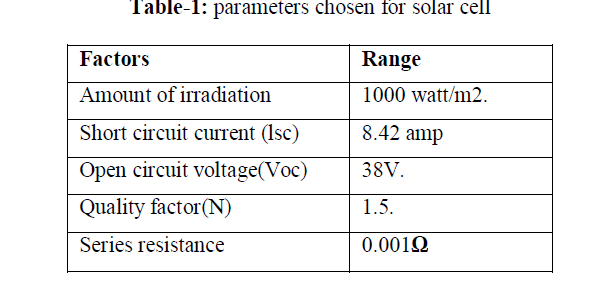 |
CUK REGULATOR |
| The basic operation of Cuk converter in continuous conduction mode is explained here. In steady state, the average inductor voltages are zero, thus by applying Kirchhoff’s voltage law (KVL) around outermost loop of the circuit. |
 |
| Assume the capacitor (C1) is large enough and its voltage is ripple free even though it stores and transfer large amount of energy from input to output (this requires a good low ESR capacitor .The initial condition is when the input voltage is turned on and switch (SW) is off. The diode (D) is forward biased, and the capacitor (C1) is being charged. The operation of circuit can be divided into two modes. |
Mode 1: When SW turns ON, the circuit becomes |
 |
| The voltage of the capacitor (C1) makes the diode (D) reverse-biased and turned off. |
| The capacitor (C1) discharge its energy to the load through the loop formed with SW, C2, R load, and L2. The inductors are large enough, so assume that their currents are ripple free. Thus, the following relationship is established. |
| −Ic1 = IL2 |
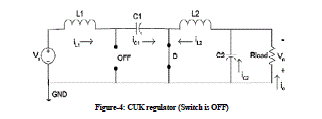 |
| The capacitor (C1) is getting charged by the input (Vs) through the inductor (L1). The energy stored in the inductor (L2) is transfer to the load through the loop formed by D, C2, and R load. |
| Ic1 = IL1 |
| For periodic operation, the average capacitor current is zero. Thus, |
 |
| where: D is the duty cycle (0 < D < 1), and T is the switching period. |
| Assuming that this is an ideal converter, the average power supplied by the source must be the same as the average power absorbed by the load, |
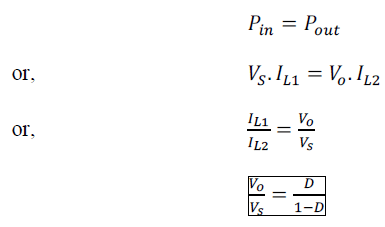 |
| Its relationship to the duty cycle (D) is: |
| 0 < D < 0.5 →the output is smaller than the input. |
| If D = 0.5 → the output is the same as the input. |
| If 0.5 < D < 1 → the output is larger than the input |
MAXIMUM POWER POINT TRACKING(MPPT) |
| For the PV source the power produced at the MPP is relatively low-current and high-voltage which is opposite of those required by the pump motor, so the MPPT is used to overcome this mismatching and obviously increase the efficiency by converting the power into high-current and low-voltage which satisfies the pump motor characteristics. |
| The MPPT could start the pump motor at 50W/m2 of irradiance. There is a MPPT specifically called a linear current booster (LCB) that is designed to overcome the above mentioned problem in water pumping systems. The MPPT maintains the input voltage and current of LCB at the MPP of PV module. As shown in the below figure, the power produced at the MPP is relatively low-current and high-voltage which is opposite of those required by the pump motor. |
| The LCB shifts this relationship around and converts into high-current and low-voltage power which satisfies the pump motor characteristics. For the example in Figure 5, tracing of the iso-power (constant power) line from the MPP reveals that the LCB could start the pump motor with as little as 500W/m2 of irradiance (assuming the LCB can convert the power without loss). |
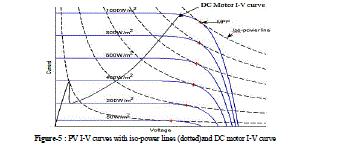 |
SIMULATION AND RESULTS |
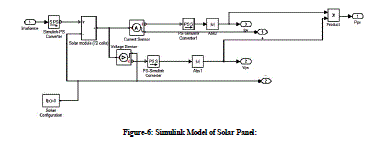 |
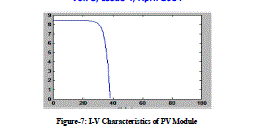 |
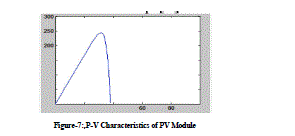 |
 |
 |
Simulink model for Solar DC Pump : |
| Solar module designed by solar cells is connected to DC motor through MPPT and a Cuk converter circuit . The modeled Solar DC pump displays the designed speed, power and duty cycle specifications. |
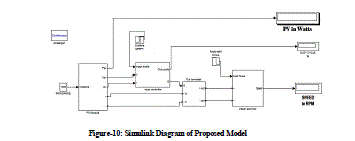 |
| The results show that the direct-coupled PV water pumping system has a severe disadvantage because the pump stays idle for nearly two more hours in the morning while the same system with MPPT is already pumping water. The result shows that the PV water pumping system without MPPT has poor efficiency because of mismatching between the PV module and the DC pump motor load. It enables to pump up to 87% more water than the system without MPPT. |
CONCLUSION |
| Due to easy installation and operation, no fuel virtually no maintenance, no fuel its high initial cost is not a major disadvantage. They have no moving parts and hence are highly reliable and durable and are modular in nature for future expansion. The temperature, insolation , power output are observed and analyzed for MPPT design. The use of an MPPT converter is not only useful for better utilization of the costly PV array and the improvement of the system efficiency, but also allows greater flexibility in the PV array configuration The modeling of each component of PV system simulated in MATLAB gives the feasibility of the system . The quality of load matching to the PV array is a critical issue for the optimal functioning of the system. The system operation varies in a wide range of power during the day, therefore a load-PV array matching is essential, over the entire operating range. A centrifugal pump powered by a PMDC motor is a good combination for this purpose. Hence the proposed model of a low cost PMDC motor has been found to be effective. |
References |
|